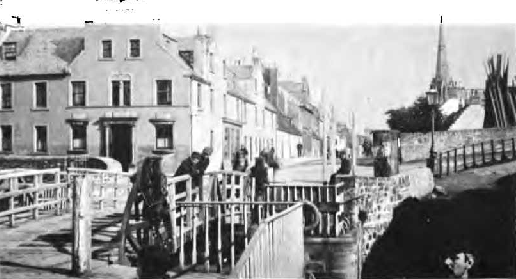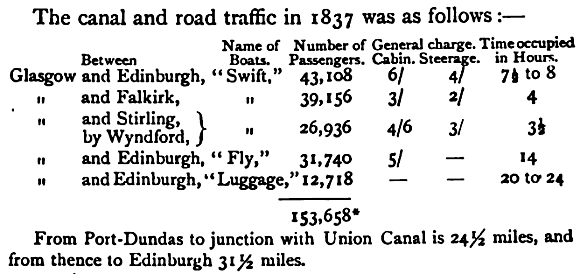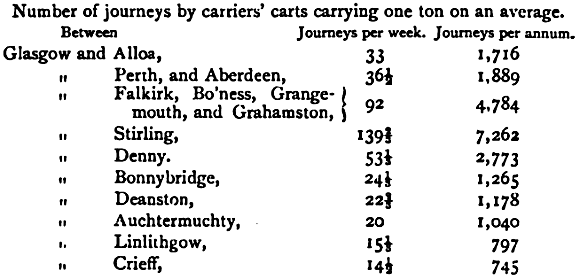|
If any person who knew
Kirkintilloch fifty to sixty years ago and left it then, were to return
to it now, he would scarcely know the ancient town. Some of the old
familiar objects still remain, but very few. The old court-house and
jail with the steeple and bell are still unchanged, and the Townhead
“Brig” over the canal has not been dispensed with; the canal itself
having still the old familiar aspect. Everything else, speaking
generally, has been “transmogrified embellished, or replaced: even
“Luggie Brig" he would find as an old friend with a new face.
Thatch roofs are now a
thing of the past; only a few being left; and the old buildings are
replaced by handsome houses and shops; few empty spaces next the streets
being now unoccupied. Pavements are universal with well-made kerbs; and
the sewerage of the town may be said to be perfect. Some handsome new
churches have been erected, and many elegant villas at Bellfield and
other suburbs. Water is brought in abundance from the Campsie hills by
gravitation.
The present generation
can scarcely conceive the appearance and condition of the town, say
about 1838.
Most likely the first
houses would be built around the Cross near the old fort, and the east
road from it to the river Luggie for watering of cows probably, would
determine the line of East High Street; West High Street would no doubt
be always the road to Glasgow; and the Cowgate is almost sure to have
been from its name, the “gate” or road along which the cows were driven
to pasture; although all these names are too old for their origin to be
handed down even by tradition.

Townhead, from the Canal Bridge.
As the place began to
increase and new buildings were erected, the magistrates would no doubt
see that these roads or streets were kept a certain width clear of
buildings or obstructions, but in all other respects everyone must have
been left to the freedom of his own will to build his house high or low
as he chose, and with either the front or the gable, or one of the
corners facing the street, just as he fancied. As regards side streets,
they were out of municipal control altogether, and seem to have been
originally formed, and the houses built, as the proprietors found it
convenient for their own purposes. At all events such was the opinion
generated at the sight of the town about the period named—to use a
phrase much used by boys at that time, the place seemed to have “hung as
it grew.”
Many of the houses had
thatch roofs, and there were neither pavements nor drainage. Huge open
gutters or “sheuchs” on either side of the streets, received all the
sewage, and the odour from them in warm weather was anything but
agreeable. Water-closets had not then been invented, and every house had
its own “midden” or dunghill, which was only emptied when it was full to
overflowing.
It is said that the city
of Cologne at one time afforded seventeen distinct smells, and
Kirkintilloch although deficient in number, might rival it in the
distinctness of its smells. Little wonder that fevers and other diseases
were rife, or that cholera committed its ravages.
All this is completely
changed now, and is only referred to as a matter of history. Nor are the
people at that period to be blamed: the evils were the growth of
centuries of habit; and sanitary science was unknown and undreamt of,
most towns in Scotland being in the same state.
The towns of England seem
to have been no better, for John Shakespeare, father of our great
dramatist, was in 1552 sued along with others for-piling up a dunghill
in Hanley Street, Stratford-on-Avon: and in 1558 he was, among other
persons fined “fourpence” for not keeping their gutters clean. David
Garrick, the celebrated actor who in 1769 conducted a gala or festival
in honour of Shakespeare, wrote of Stratford-on-Avon as “the most dirty,
unseemly, ill-paved, wretched looking town in all Britain.”
“I asked the magistrates
of Inverness one day, when the dirt was almost above one’s shoes, why
they suffered the town to be so excessively dirty and did not employ
people to clean the streets? The answer was—‘ It will not be long before
we shall have a shower.—Burt, 1630.”
When the municipal
authorities of a certain Scotch town, anxious to improve its sanitary
condition, were endeavouring to persuade the inhabitants to remove the
heaps of ashes and refuse which lay before their doors, one old
dame—indignant at this encroachment upon her rights—seized the
broomstick, mounted guard upon her rubbish, and exclaimed in tragic
tones to the councillors, “Na, na, gentlemen, ye may tak my life, if ye
will hae’t, but ye shanna touch my midden.”
They were, after all,
only in somewhat of the condition of the Saxon Princess Rowena, whose
bedroom walls "were covered with richly embroidered hangings, and
illuminated with large wax torches; but the walls were so full of
crevices that the hangings shook to the night blast, and the flame of
the torches streamed sideways into the air; comfort being unknown it was
unmissed," The wells of the town were great and valuable institutions,
being few in number and the only resource of the inhabitants for water.
Only two of these were public wells; one in the Townhead, and another in
the Cowgate; and such was their importance, and the demand on their
resources, that large committees were appointed to see fair play, and
that each could only draw water in turn. There was a good well at the
granary near Luggie Bridge, another on the opposite side of the street
at Bailie Dickson’s, and one at Braehead, the water of which had the
reputation of being good but hard. A fourth was at the Peel, and it is a
slur on some one that it is not open at this day as a curiosity, which
it would be to many. The late Hugh Macdonald author of “Rambles round
Glasgow” visited it, and thus writes of it in 1856 :—
“A well faced with stone
still occupies a portion of the fosse; and while we are lingering on the
spot, a boy from the neighbouring town comes to fill his “stoups” at the
very fountain from whence the soldiers of Antonine may have drawn the
same cool and crystal fluid 2,000 years ago”
In a drought the people
had to get water from the river Luggie which served for some purposes,
but bakers had to get good water carted from considerable distances.
Before the introduction
of gas it can easily be guessed that walking the streets on moonless
nights was never a recreation, and for children it was a painful task.
To add to the horrors of the "sheuchs,” and the danger of falling in,
the air was thick with rumours of resurrectionists, and stories of Burke
and Hare. There was also a pretty strong belief in ghosts and witches.
With all the modem
improvements, however, and the increased comforts and conveniences of
civilisation, somehow or other Kirkintilloch was even a more lively and
“heartsome” place then than now.
These were the days of
the mail coaches and carriers carts, before railways were much in vogue;
and the old town had her full share of the profit and excitement of the
traffic on the roads, which were the principal mediums of conveyance for
passengers and goods.
But the canal was quite
as interesting as the roads, for the trade on it was also very great.
All the traffic between Edinburgh and Glasgow, Falkirk, and other places
on the route, passed through Kirkintilloch; and the passenger boats were
objects of unceasing interest Boat-houses or sheds were erected on
either side of the Townhead bridge, for the convenience of the
travelling public.
There were three kinds of
boats for passengers then in use viz.: “swifts,” “flys,” or “hoolets,”
and "luggage boats.”
The “swift,” as its name
betokens, was the fastest, and carried only passengers, with their
personal luggage. The traffic paid the canal company well, and they
spared no pains nor expense to get the best horses, in order to keep up
the reputation for speed and regularity which the “swifts” had acquired.
They were drawn by two horses in each—one in front of the other, the
rider on the rear horse being always a young lad in smart livery,
guiding both animals, and carrying a long whip to aid him, which he
could crack like a pistol-shot.
No one in Kirkintilloch
now cares a button about the arrival of a train from Glasgow unless
friends are coming, but the arrival of the “swift” from Glasgow every
evening was an event that interested the whole inhabitants. If the
majority did not expect friends, they knew others who did, and all
shared an interest in the event of the day. In fact, there was a
feverish expectation pervading the whole place for an hour previously,
which nothing could allay, but the arrival and departure of the object
itself, after which the town settled down for the night. There was
always a small crowd, more especially of boys, awaiting the arrival of
the “swift,” and straining their eyes to catch the first peep of it
coming round the turn; and, when she did appear, not an eye was diverted
from her till she fairly drew up. But a good deal happened before that
event. The Irish post-boy always reserved a trot for the avenue, and the
“swift,” in approaching Kirkintilloch, put its best foot foremost—if we
may use the expression—the post-boy having always in reserve not only a
trot but a full gallop.
We shall try to impart to
our readers some idea of the grandeur of the scene which impressed our
youthful imagination so, that at the expiry of over fifty years the
recollection vividly remains. Let the reader imagine himself to be
standing at the canal bridge while the boat is gliding “swiftly” towards
him and just approaching the foot of the hill: suddenly a loud blast of
the captain’s horn is heard, plainly announcing “look out, we are
coming,” just as if the Kirkintilloch people would not know, or might
forget—why, they were looking out for the captain far more anxiously
than he was for them. The blast however might be meant for the post-boy
too; at all events as soon as he heard it, crack went his whip, and off
went the horses at a gallop up the hill. They were no time in mounting
that hill, you saw them at the foot, and before you had time to breathe
there were the two panting animals alongside of you, the post-boy
sitting like a king on his throne, and as grandly dressed. Talk of the
Derby! it is nothing to it.
The “hoolets” went
chiefly by night, as their name implies, but some went by day as well.
They were drawn by three or sometimes four horses, the driver riding a
pony alongside. They carried goods and passengers, but, going at a slow
rate, seldom carried more than ten or twelve travellers in each. They
were favourites with many however, for fast travelling was not coveted
then as it is now, and they were comfortable, easy-going vessels with
two decks, and a steward's room where eatables, and more especially
drinkables, were sold. Newspapers in these days were scarce, and readers
still scarcer, so that the people on board were driven to pass the time
in spinning yarns as sailors call it, and cracking jokes.
There is a part of the
canal near Auchinsterry where there is a very sharp curve—the sharpest
on the whole canal —it is known as the Elbow Point, but better still as
“the Deil’s Elbow.” A sailor had been entertaining his fellow travellers
from Glasgow with the wonders he had seen and the places he had sailed.
The boat was just turning the Elbow Point, when a passenger asked him if
he had ever sailed round the Deil’s Elbow. “No,” said the sailor, “I
never heard of it.” “I beat you there,” said the other, “for I have
sailed round it many times, and here it is.” In the time of harvest,
many Irishmen came over to the Broomielaw and took passage by the
“hoolets” for the eastern counties. They often wore leggings of a
material not now used for that purpose, being simply a straw rope
twisted round the leg from the ankle to the knee, and very often they
carried geese in their arms, brought all the way from Ireland.
The “luggage” boats
carried generally only goods, and travelled slowly—they were built to
carry forty tons.
The canal company had
extensive stables built at regular stations all along the canal, and the
horses were very frequently changed, the speed at which they were driven
being such as could not be long maintained. The first stage from Glasgow
was at Lambhill, next, Glasgow Bridge, then Shirva, Craigmarloch, and so
on.
The canal company in 1852
leased their passenger traffic to Messrs. A. & J. Taylor who kept a boat
plying, drawn by horses, till i860, when they procured a new screw
steamer, the Rockvilla. It was sold after a few years to Mr. George
Aitken, who carried it on with much acceptance to the public—with whom
he was a favourite—till he was unfortunately drowned, when the boat was
sold to go to Paisley; she carried twenty-six cabin, and sixty steerage
passengers.
The glories of canal
passenger traffic have been revived this year, better than ever, by
Messrs. James Aitken & Co., Limited, who have the s.s. Fairy Queen built
at Irvine and carrying about 250 passengers. She is two-decked, and is
another Columba in miniature—one advantage being that in the event of
her sinking, the passengers have just to remain on the upper deck, and
they will not be immersed, the canal not being deep enough to drown
them. The Fairy Queen is an elegant and commodious vessel and has a
comfortable saloon, besides a refreshment room. She plies between
Glasgow, Kirkintilloch, and Craigmarloch, and is well patronised,
especially by picnic parties.
There is a place on the
canal a little west of Kirkintilloch called by the singular name of
Hungryside—the captain of one of the swifts used to say that it was
wrong-named altogether, for more fat women came on board there than any
place on the canal.
Besides all this, an
immense amount of cartage of goods was going on. The Hurlet and Campsie
Alum Company brought all their supplies by canal to Hillhead, from
whence they were carted to their works at Campsie, and a large staft of
horses and carts was required for the purpose.
The quantity of coals
brought from the Monklands by rail and shipped at the basin was for
these days very great, and vessels came regularly from all parts of
Scotland for cargoes. The town people were by this means kept in regular
and friendly communication with such distant ports as Aberdeen,
Montrose, etc., not to mention a multitude of places nearer.
In this connection we
give some statistics of the traffic by road and canal.


The fare by coach between
Edinburgh and Glasgow was 14/ inside and 10/ outside—average charge
between other places, 3d. per mile. Time from Edinburgh to Glasgow, five
hours; and between other places, eight miles per hour. The distance by
road from Edinburgh 10 Glasgow is, via Bathgate and Airdrie, 43 miles;
via Shotts, 43 miles ; and via Falkirk, 47½ miles.

As a result of the slow
and limited means of communication with the outside world, the people of
Kirkintilloch were thoroughly provincial in spirit. The parish was their
country, and beyond it were folk with whom they had little or nothing to
do. The town itself was divided into imaginary sections—the Cowgate and
Broadcroft looked on the Townhead as a friendly people, but occupying a
different territory; and Hillhead was a distant outpost.
As may be supposed,
strangers had to run the gauntlet of all eyes and tongues; and if one
settled down in the town, he was regarded as a foreigner or “ incomer,”
as the phrase was, for many a day.
People then lived a
quieter and simpler life than now, and were never in a hurry. It was a
proverb in use, “Naething should be done in a hurry except catching
fleas.,,
There was a great deal of
quiet social enjoyment, which would be too slow for the present
generation. Commercial travellers came by coach generally, and stayed a
night or two, being always hospitably entertained by the inhabitants,
and made lions of, for the sake of the “gran crack” they gave, and the
wonderful news they brought from the outside world, even so far distant
sometimes as Manchester or Birmingham. |

